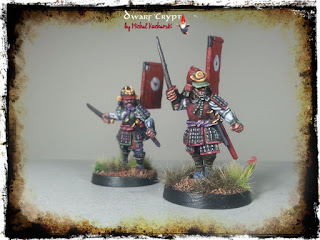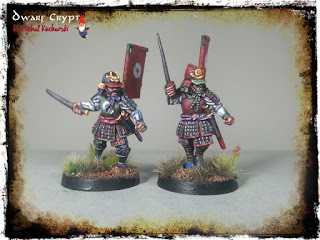[ENG/PL] The Way of the Samurai / Droga Samuraja (Ronin Bushi Buntai #1)
„Sword is the soul of a samurai, If one forgets or lose him, will not be forgiven“ -testament of shogun Ieyasu Tokugawa (fragment)
„Miecz jest duszą samuraja, Jeżeli ktoś o nim zapomni lub go utraci nie będzie mu to odpuszczone“
-fragment testamentu szoguna Ieyasu Tokugawa
Dziś na DwarfCrypt zapraszam na podróż do kraju Kwitnącej Wiśni okresu feudalnego. Do opowiedzenia tej historii posłużą mi świeżo pomalowane figurki od North Star Military Miniatures z gry Ronin, którą rozpakowywałem w TYM miejscu. Samuraje, bo o nich mowa, to jedna z najbardziej rozpoznawalnych grup społecznych w historii. Ale od początku...
Samuraj, czyli inaczej wojownik jest st to szeroko rozpowszechniona na Zachodzie nazwa feudalnego rycerza japońskiego – w Japonii przeważnie nazywanego Bushi, co przyznam się bardzo mi się podoba i zdarzy mi się zamiennie użyć tego zwrotu.
Nazwa ta przeszła z czasem zmianę fonetyczną w samurau, co znaczy „służyć panu„.
Pierwotnie znaczyła świtę służącą najwyższym dostojnikom japońskim. Byli także gwardią cesarską tzw gosho-zamurai.
Symbolem pozycji Bushi była samurajska szabla katana i krótki miecz wakizashi, razem stanowiące komplet zwany daishō. Ich noszenie było prawem i obowiązkiem japońskich wojowników. Daishō nie były tylko bronią. Mówiono o nich, że stanowią duszę samuraja, toteż samuraje byli silnie związani ze swoimi mieczami i otaczali je głęboką czcią. Tą niezwykłą więź możecie zobaczyć w wielu książkach i praktycznie w każdym filmie o Samurajach. Nawet kultura zachody zaadaptowała mit Samuraja w takich obrazach filmowych jak Kill Bill czy mój ulubiony (oprócz każdego filmu mistrza Akira Kurosawy) Ghost Dog. Droga Samuraja.
Co ciekawe, charakterystyczna dla samurajów była ich fryzura, czyli włosy upięte na czubku głowy i wygolone z przodu, nad czołem. Nosili również strój składający się m.in. ze spodni hakama, kamizelki kamishimo, na których widniał często kamon (herb klanu/rodziny), i innych dodatków takich jak np. amulet szczęścia wieszany na szyi.
Samurajska zbroja Ō-yoroi składa się z wielu segmentów, głównie metalowych, które pokrywano skórą i lakierowano, po czym łączono za pomocą grubych pasków z jedwabiu i skóry. Paski te − jaskrawo kolorowane − stanowiły element dekoracyjny zbroi. Próbowałem uzyskać ten efekt na figurkach poniżej.
Istniało w Japonii bardzo wiele szkół walki. Wprawny samuraj potrafił zabić przeciwnika już za pierwszym ciosem, a nawet jednym cięciem przeciąć go na pół, wzdłuż od czubka głowy. Owe śmiercionośne umiejętności wynikały ze sposobu walki, który polegał przede wszystkim na rozpoznaniu szkoły w jakiej kształcił się oponent, a co za tym idzie używanej przezeń techniki, dzięki czemu samuraj mógł błyskawicznie zastosować opracowaną metodę kontrataku. Ze względu na charakter tej walki, nastawionej na zadanie śmierci niemal jednym ruchem miecza, bywało, że kończyła się ona zgonem dla obu stron…
Samuraj kształcony był nie tylko w posługiwaniu się mieczem, ale także łukiem (jumi), jak również innymi rodzajami broni, jak np.: włócznia zwana yari, broń drzewcowa o nazwie naginata, czy wachlarz bojowy tessen.
Podstawowe prawa samuraja zawarte były w kanonie bushidō, wykładającym podstawowe zasady drogi wojownika. Istniały również inne dzieła, opisujące zasady, jakimi powinien się kierować samuraj. Były to między innymi utwory Gorin-no Sho (Księga pięciu kręgów) oraz Hagakure (Ukryte w listowiu).
Główną zasadą kodeksów była wierność swemu panu i bezwzględne podporządkowanie się. W walce samuraj nie mógł odczuwać lęku przed śmiercią (podobnie jak podczas popełniania seppuku), nie mógł kapitulować w walce, byłoby to bowiem rozwiązanie niehonorowe.
Samuraje byli kształceni w kierunku poznania bushidō, uczono ich między innymi czytania, pisania, sztuki kaligrafii, literatury, muzyki, retoryki, taktyki, prawa, medycyny, matematyki oraz parzenia herbaty. Wykładano im także poezję japońską i chińską.
A jaki jest wasz ulubiony film w duchu bushi?
Dieser Artikel stammt von einer der angeschlossenen Quellen. Bitte honoriere die Arbeit der Autoren indem du ihren Webseite besuchst.
Artikelquelle besuchen
Autor: DwarfCryptDwarfCryptDwarfCrypt
Powered by WPeMatico












